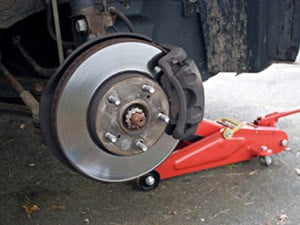Brake Pads
Brake pads convert the kinetic energy of the car to thermal energy by friction. Two pads are contained in the brake caliper with their friction surfaces facing the rotor. When the brakes are hydraulically applied, the caliper clamps or squeezes the two pads together into the spinning rotor to slow or stop the vehicle. When a brake pad is heated by contact with a rotor, it transfers small amounts of friction material to the disc, turning it dull gray. The brake pad and disc (both now with friction material), then “stick” to each other, providing the friction that stops the vehicle.

In disc brake applications, there are usually two pads per disc rotor, held in place and actuated by a caliper affixed to a wheel hub. Depending on the properties of the material, disc wear rates may vary. They must be replaced regularly (depending on pad material), and some are equipped with a method of alerting the driver when this needs to take place. Some have a thin piece of soft metal that causes them to squeal when the pads are too thin, while others have a soft metal tab embedded in the pad material that closes an electric circuit and lights a warning light when the pad gets thin.
Disc brake advantages
These brakes offer better stopping performance than comparable drum brakes, including resistance to “brake fade” caused by the overheating of the components, and are able to recover quickly from immersion.
Materials
Materials range from asbestos to organic or semi-metallic formulations. Each of these materials has proven to have advantages and disadvantages regarding wear, noise, and stopping capability.
Semi-metallic pads provide strength and conduct heat away from rotors but also generate noise and are abrasive enough to increase rotor wear. Ceramic compounds and copper fibers in place of the semi-metallic pad’s steel fibers accommodate higher temperatures with less heat fade and generate less dust and wear on both the pads and rotors. They also provide much quieter operation due to the ceramic compound that helps dampen noise by shifting its resonant frequency beyond the human hearing range and reduced metal use (approximately 15% metal content by weight).
Asbestos was widely used in pads for its heat resistance but, due to health risks, has been replaced with alternative materials.
Calipers
The caliper is the assembly that houses the brake pads and pistons. The pistons are usually made of aluminum or chrome-plated steel.

Calipers are of two types, floating or fixed. A fixed caliper does not move relative to the disc and is thus less tolerant of disc imperfections. It uses one or more single or pairs of opposing pistons to clamp from each side of the disc, and is more complex and expensive than a floating caliper.
A floating caliper (also called a “sliding caliper”) moves with respect to the disc, along a line parallel to the axis of rotation of the disc; a piston on one side of the disc pushes the inner brake pad until it makes contact with the braking surface, then pulls the caliper body with the outer brake pad so pressure is applied to both sides of the disc. Floating caliper (single piston) designs are subject to sticking failure, caused by dirt or corrosion entering at least one mounting mechanism and stopping its normal movement. This can lead to the caliper’s pad’s rubbing on the disc when the brake is not engaged or engaging it at an angle. Sticking can result from infrequent vehicle use, failure of a seal or rubber protection boot allowing debris entry, dry-out of the grease in the mounting mechanism and subsequent moisture incursion leading to corrosion, or some combination of these factors. Consequences may include reduced fuel efficiency and excessive wear on the affected pad.


